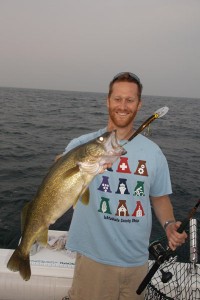Heavy ice cover, the kind that lasts well into the spring, could be the best thing that Lake Erie walleye anglers could hope for, according to Jeff Tyson, Ohio’s lead guy in charge of Lake Erie’s fish management efforts.
Ice cover
Tyson said that if history repeats itself, this year’s walleye hatch should be a good one and although August test netting will tell the rest of the story, ongoing netting has already produced an impressive number of walleye youngsters.
Walleye hatch

Last year’s hatch, which also followed a long winter freeze, was above average and another one this year would really boost Lake Erie’s walleye numbers in coming years. Tyson said that thick, long-lasting ice cover allows more angler access and that means more trophy egg laden walleyes removed from the lake just prior to the spawn but overall, the winter harvest is not significant in the big picture. After all, Lake Erie’s famous walleye and yellow perch fishing is all about numbers and the numbers are all based on natural reproduction.
Most productive lake
Tyson said that Erie is easily the most productive of all the Great Lakes and that on-going research efforts provide windows into the habitat and seasonal movements of the fish. In some cases, blocks to good spawning grounds in Lake Erie tributaries, have been cleared to allow more walleyes to reach more good spawning areas but no fish are stocked. The only exception are steelhead trout which are indeed stocked in select streams but live, grow, and produce exciting fishing thrills in the open waters of Lake Erie.
Yellow perch population
Interestingly, yellow perch numbers follow the same ups and downs as those of walleyes. Currently, perch numbers are extremely low and more good spawning seasons are needed to insure a steady recovery.
Billion dollar economy
Tyson said that although Erie supports several fish species, walleye and yellow perch are by far the kings, the two species that drive a billion dollar economy. Ohio is just one of a multi-jurisdictional management co-operative strategy including Michigan, Pennsylvania, New York and Ontario.
“What happens in one jurisdiction affects all of the rest,” Tyson said, as he described the Lake Erie Fisheries Commission, which sets levels of harvest (not-to-exceed-quotas) for each jurisdiction. “Whatever decisions are made have to be agreed on by all of us,” he said.
Fortunately, commission members are open and sharing with their data and strategies which allow a solid foundation of trust for healthy overall lake management. Since management strategy is one dimensional, depending entirely on harvest quotas, it is important that quotas are set to support safe levels of harvest while meeting the social and economic needs of each jurisdiction, Tyson said.
Fish population
Quotas are set after wide spread data is collected from trawl and test netting, dock side creel counts, and commercial harvests are entered into a modernize computer model that projects trends and provides current lake-wide populations of fish. Who catches Lake Erie walleyes? Tyson had the answer.
Several years ago nearly all Lake Erie walleyes were caught by drifting and casting lures but currently 18% are caught by drift casting, 50% by flat line trolling, and the rest by deep trolling with devises such as downriggers. That means about 80% are caught by trolling.












